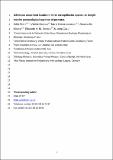Files in this item
Inferences about food location in three cercopithecine species : an insight into the socioecological cognition of primates
Item metadata
| dc.contributor.author | Petit, Odile | |
| dc.contributor.author | Dufour, Valerie | |
| dc.contributor.author | Herrenschmidt, Marie | |
| dc.contributor.author | De Marco, Arianna | |
| dc.contributor.author | Sterck, Elisabeth H. M. | |
| dc.contributor.author | Call, Josep | |
| dc.date.accessioned | 2016-02-20T00:12:40Z | |
| dc.date.available | 2016-02-20T00:12:40Z | |
| dc.date.issued | 2015-07 | |
| dc.identifier | 240324864 | |
| dc.identifier | 7ed8b3ee-e7fa-4827-906d-6942f3e608a4 | |
| dc.identifier | 000355923300002 | |
| dc.identifier | 84930537546 | |
| dc.identifier.citation | Petit , O , Dufour , V , Herrenschmidt , M , De Marco , A , Sterck , E H M & Call , J 2015 , ' Inferences about food location in three cercopithecine species : an insight into the socioecological cognition of primates ' , Animal Cognition , vol. 18 , no. 4 , pp. 821-830 . https://doi.org/10.1007/s10071-015-0848-2 | en |
| dc.identifier.issn | 1435-9448 | |
| dc.identifier.other | ORCID: /0000-0002-8597-8336/work/37478054 | |
| dc.identifier.uri | https://hdl.handle.net/10023/8273 | |
| dc.description.abstract | Many animal species use a variety of cognitive strategies to locate food resources. One strategy is to make inferences by exclusion, i.e., perceiving the absence of reward as a cue that another location should be investigated. The use of such advanced cognitive strategies may be more prominent in species that are known to frequently solve social challenges, and inferential reasoning has mainly been investigated in social species such as corvids, dogs, dolphins and non-human primates. In this paper, we investigate how far social intricacy may explain the disparity of reasoning performances observed in three cercopithecine species that differ in the density of their social network and the diversity of their social partners. We used standard reasoning tasks, testing the volume concept and inference by exclusion using visual and auditory modalities. We showed that Old World monkeys can infer the location of invisible food by exclusion. In addition, Tonkean macaques and olive baboons had greater performances in most tasks compared to rhesus macaques. These responses are consistent with the social complexity displayed by these three species. We suggest that the cognitive strategies required to navigate through a demanding social world are involved in the understanding of the physical domain. | |
| dc.format.extent | 10 | |
| dc.format.extent | 404643 | |
| dc.language.iso | eng | |
| dc.relation.ispartof | Animal Cognition | en |
| dc.subject | Inference by exclusion | en |
| dc.subject | Causal reasoning | en |
| dc.subject | Social complexity | en |
| dc.subject | Macaca tonkeana | en |
| dc.subject | Papio hamadryas Anubis | en |
| dc.subject | M. mulatta | en |
| dc.subject | QL Zoology | en |
| dc.subject | BF Psychology | en |
| dc.subject | NDAS | en |
| dc.subject.lcc | QL | en |
| dc.subject.lcc | BF | en |
| dc.title | Inferences about food location in three cercopithecine species : an insight into the socioecological cognition of primates | en |
| dc.type | Journal article | en |
| dc.contributor.institution | University of St Andrews. School of Psychology and Neuroscience | en |
| dc.contributor.institution | University of St Andrews. Centre for Social Learning & Cognitive Evolution | en |
| dc.identifier.doi | 10.1007/s10071-015-0848-2 | |
| dc.description.status | Peer reviewed | en |
| dc.date.embargoedUntil | 2016-02-20 |
This item appears in the following Collection(s)
Items in the St Andrews Research Repository are protected by copyright, with all rights reserved, unless otherwise indicated.

